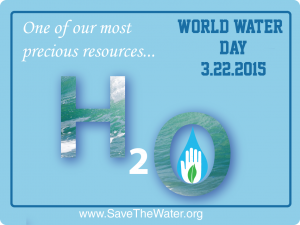
By Olivia Philips, Staff Writer for Save The Water™ | March 5, 2015
It takes approximately 33 ounces of water to create a single sheet of paper; it takes about the same amount of water to irrigate one calorie worth of food.8 While 70% of our earth is blanketed with water, only about 3% is fresh water, and of that fresh water, only about 25% is accessible4 — if you’re still following, that means only .75% of the world’s water is fresh and accessible for use. Additionally, even in places where water may not be physically scarce by nature, scarcity is becoming a threat as a result of overuse or over management.1 It is estimated that by 2025, 67% of the world’s population may face water shortages.4 In graphic terms, that means the equivalent of nearly 15 United States populations may face water shortages.
World Water Day was launched in 1993 by the United Nations General Assembly as a day to celebrate water and shine a light on its importance in our world. Since the launch, every March 22 has marked and brought awareness around the world to a different water-related theme; this year, the theme is “Water and Sustainable Development,”1 highlighting the issue of water scarcity. Water is a resource used every single day, often times irresponsibly or absentmindedly, making this theme highly relevant for today.
Water scarcity is an issue for a number of reasons—some of which are more obvious than others. First and foremost, water is essential to bodily health. Lack of access to clean, fresh water, a life-sustaining resource, is a daily struggle for many throughout the world. This lack of availability drives the incidences of water-related illness and disease up, especially in impoverished communities. The human body can only survive for a few days without water.8 Facing death by dehydration, many throughout the world are forced to drink from unclean water sources, where pathogens and bacteria thrive, and the likelihood of developing diseases such as dysentery and cholera increases. For some, storing water within the home seems like a practical option in order to reduce travel time and fatigue, but storing water, even if clean, also creates health risks, as the stagnant water creates an environment where mosquitos carrying malaria or other diseases can breed.5 Lack of clean water is more than an unfortunate circumstance—for many, it’s a death sentence.
Even for those in communities where access to clean drinking water is not an issue, effective water management is relevant. Every processed item demands water for the manufacturing cycle, from ground beef to the plastic it’s packaged in, and demand for water will only increase in the coming years as the global population rises,6 especially in developing countries. Currently, maximized production reigns supreme over water efficiency in many of the industries that use water most heavily. Water shortages could lead to higher prices for goods and services, or it could eliminate some products altogether. Another issue created by many industrial centers is the water output created. Often, dirty, used water from factories and mills merges with clean water in rivers, bays, and other natural bodies, leading to cross contamination of once clean water.8 In some communities where water is scarce, this dirty wastewater—and other types of wastewater— is used to irrigate crops, which are then shipped to consumers that are often unaware of this fact.5
Water scarcity creates political issues, as well. By 2050, the global population is estimated to rise to anywhere from 8 to 9 billion.6 In areas that lack major access to natural bodies of fresh water, effective water management will continue to be an issue as the population rises and water becomes less accessible. Many communities share sources of water with neighboring peoples, and the increasing struggle over water and its management creates tensions or deepens existing culture strife, such as in sub-Saharan Africa.3 Even in regions with abundant natural water sources, such as areas along the Colorado river,1 water management policies that do not emphasize responsible management are leading to overuse that is costly and difficult to correct.
While any of these types of issues alone are serious, they become a bigger problem when combined. When government policies mismanage how water is distributed, people, usually women or children8, often resort to traveling long distances to acquire fresh water, which then creates difficulty for retaining jobs or receiving an education. Without jobs or educations to make a living out of, many cannot afford high prices of goods created by industries that use water—which, because of scarcity, only rise higher as more water is used irresponsibly— contributing to the cycle of poverty in many regions of the world.6

This year’s World Water Day is especially important to be aware of, because the efficacy of water management in our homes, work places, or elsewhere will affect our world for decades to come. Many have already taken small steps in the right direction—turning off the faucet while brushing our teeth, taking quick showers, reusing water to water household plants. Others are taking giant leaps—Bangladesh’s Water PaCT, or Partnership for a Cleaner Textile, is endorsing technology that ensures that water coming out of textile mills is cleaner than when it came in. The British retailer Tesco, Swedish clothing company H&M, and the Kingdom of the Netherlands are among some of the supporters of the Water PaCT, signaling that water purity and the responsible use of this resource is a multinational issue. 2
Because water scarcity and responsible management is an issue that affects everyone, there are events scheduled to take place across the globe raise awareness and in celebration of World Water Day 2015. In the United States, there will be a screening of Cowspiracy, an documentary covering the topic of the beef industry and its environmental costs, in Chicago, Illinois; in Miami, Florida, university students will be pledging to “Take Back the Tap,” by reducing their consumption of bottled water and supporting policies that promote responsible water management. In Africa, there will be a water conservation symposium and community event in Swaziland, and a ground breaking on two solar powered water pump sites in Ghana, which will eventually provide up to 10,000 liters, or about 2,600 gallons, of water per day to villages with anywhere between 500-2,000 inhabitants. Throughout the United Kingdom there will be fundraisers for charities that target water sustainability issues; in Germany, the Global Nature Fund will announce the “Living Lake of the Year,” which will celebrate and support the sustainability of unique natural habitats and ecosystems throughout the country.7
This is just a small sampling of the hundreds of events taking place across the world to bring awareness to the issue of water scarcity. Water scarcity is an issue that can only be solved by working together. Check to see if there are any events happening in your area by visiting the World Water Day website at https://www.worldwaterday.org/, research how your community is specifically affected by water scarcity, and get involved this March 22.
Sources
- “About World Water Day.” World Water Day 2015. UN Water. Web. 23 Feb. 2015. <https://www.worldwaterday.org/>.
- “FAQs: Cleaner Production, Deep Dives and Water Footprint.” Bangladesh Water PaCT: Partnership for Cleaner Textile. Bangladesh Water PaCT. Web. 24 Feb. 2015. <http://www.textilepact.net/general-faq/>.
- “Global Water Shortage: Water Scarcity & How to Help.” The Water Project. The Water Project. Web. 24 Feb. 2015.<http://thewaterproject.org/water_scarcity_2>.
- “Threats: Water Scarcity.” WorldWildlife.org. World Wildlife Fund. Web. 24 Feb. 2015. <http://www.worldwildlife.org/threats/water-scarcity>.
- “Water Scarcity.” WORLD NATURE ORGANIZATION. WORLD NATURE ORGANIZATION. Web. 24 Feb. 2015.<https://www.un.org/waterforlifedecade/scarcity.shtml>.
- “Water Scarcity: Social Implications.” Going Blue: Water, Economics, Life. Going Blue. Web. 24 Feb.2015.<http://www.growingblue.com/social-implications/>.
- “World Water Day 2015: Events.” World Water Day 2015. UN Water. Web. 24 Feb. 2015. <https://underwater.org/>.
- “World Water Day 2015: Learn.” World Water Day 2015. UN Water. Web. 24 Feb. 2015. <https://underwater.org/>.

